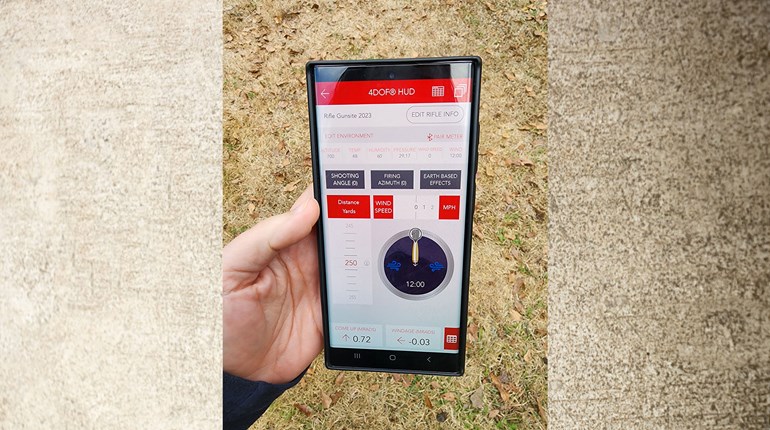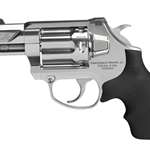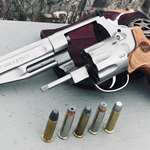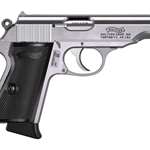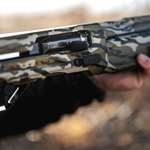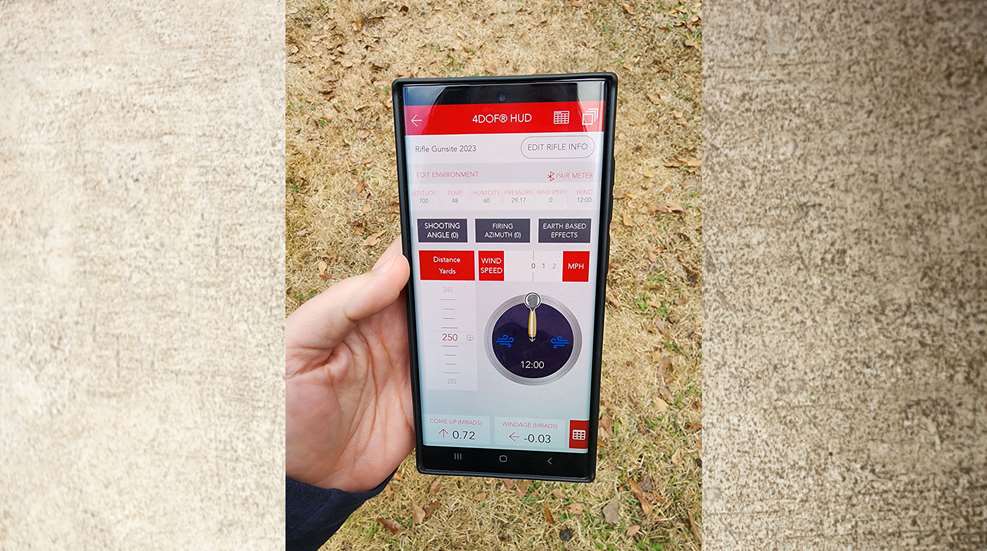
When you’re shooting a rifle, you probably already know that your bullet drops as it travels through the air. The farther you shoot, the lower it drops, and you must either hold your reticle/aiming point higher or, preferably in most cases, dial your scope’s elevation turret up so that you can still put the center crosshairs on your target and the scope will have been adjusted for the bullet’s drop.

The trick is to know how far the bullet will drop at any given distance. These numbers—determined by a projectile’s ballistic coefficient, which is an approximation based on calculations—are printed on most boxes of rifle ammo, at least out to a few hundred yards. They’ll be in inches, because they’re primarily for hunters. These numbers are averages, and they’re imprecise, because many factors—everything from elevation to atmospheric pressure to your rifle’s twist rate and much more—can change them. If you’re going to get serious about long-range shooting, you’ll want much more precise numbers at longer ranges, and you’ll want them in MOA or mils, whichever your scope uses. I use MOA most often, and it’s the most common in the U.S., so that’s what we’ll use for the purposes of this discussion.
The calculations needed to get those bullet-drop numbers are pretty complicated trigonometry I have no interest in doing. Fortunately, the advent of ballistics apps for your smartphone have made this easy. Just download an app, input your ammo and your rifle’s information, tell the app what the atmospheric conditions are (some even do this automatically by connecting to local weather stations) and the app will spit out a chart of bullet drop at any very specific distance you could ask for.
There are many free apps that do a great job at this, and some paid ones that you might find helpful once you really get into the nitty-gritty of serious long-range shooting. What should you ask yourself when you’re looking for a ballistics app?
How Far Do You Plan to Shoot? If you’re hunting, and you’re limiting your shots to 300 yards or so, a very simple app that uses BC will suffice. If you’re planning to shoot out to 1,000 yards, a mile or even farther, especially in competition, you need the most precise numbers possible. Which leads to the next question…
Do You Need BC or Drag Curve? Some apps will give you the simplified drop numbers based on ballistic coefficient. As mentioned, ballistic coefficient will always be an approximation because it's derived from a calculation. Drag curve, on the other hand, is precise, because the company providing the data has actually used Doppler radar to measure the projectile’s exact flight, taking measurements every millisecond. In other words, ballistic coefficient-based numbers represent what a bullet’s flight should be, while drag curve-based numbers represent what the flight actually is. BC is good enough for hunting and for long-range plinking out to a few hundred yards. Beyond that, you’re going to want the precision of drag curve-based numbers if you can get them. Because this radar process requires really expensive equipment, it’s not available via every app. Only major companies (Hornady being a good example) have put in the effort and money to measure bullet flight so precisely.
How Complicated Are You Willing to Get? Apps vary widely in how much information they take in and spit out. Some are loaded with extra features like the ability to take photos of your targets and label them, space for a hunting diary, connectivity with Kestrels, smart optics or other devices, and much more. Some have you input every atmospheric data point, while others just connect to your local weather station and don’t allow you to get more specific. The farther you plan to shoot, the more complicated you will probably want to get. If you don’t need all of the fancy stuff, you can just ignore it, or you can pick a simpler app that just gives you numbers.
What Bullets Are You Using? Some ammo manufacturers have their own apps that work with their own ammo. Some of these are extremely good and others are quite basic. If your projectile manufacturer’s app is robust enough for the shooting you plan to do, it’s a good place to start. But if you shoot different brand bullets/ammo out of different rifles, you probably won’t want multiple apps on your phone, so going with an independent app might work best for you.
Three Apps I Can Recommend
I have used two of these pretty extensively, and I have no experience with the third, but it comes highly recommended by the shooting instructors of the last long-range class I took.

Zeiss Hunting App: This is a relatively simple app as far as data goes. Just create a profile of your rifle and its ammo, then the app connects to the nearest weather station (you can tweak a few of the numbers if you like) and spits out a table of come-up (or drop) numbers in inches, MOA and mils. It’s made for use with Zeiss scopes, and it will show you a picture of your scope’s reticle with distances overlaid on it, if you find that helpful. The chart is the good stuff, though, and you can connect this app with Zeiss smart binos or other devices to make it faster.
The downside is, if your scope is another brand, many of this app’s features aren’t available or so helpful. In fact, there’s an option to “use my products,” which presumably means pick another brand of scope, but that function isn’t even working on my app, so I can’t guarantee all of this app’s features can be used with another brand of scope. The other downside is, the numbers given are all ballistic coefficient-based, which gets less and less precise the farther you shoot.
The upside is, this app is free and simple to use and works great if you have a Zeiss scope. It’s not overly complicated, and if you’re not shooting to a mile or some other situation where you want to be incredibly precise with your atmospheric conditions, the auto-connect to a weather station is very fast and easy to use.
Hornady 4DOF: If you’re shooting Hornady projectiles, you’re in luck, because Hornady has invested in that super-expensive radar measuring and thus can offer precise drag curves. 4DOF stands for 4 Degrees of Freedom, because a bullet isn’t only dropping in flight—because of all sorts of factors, it’s actually moving forward, left to right, wobbling and spinning, and the 4DOF curve takes all of that into account. This is a very robust app that lets you put in as much information as you want to nerd-out on, and it includes projectiles and ammo from many other companies, so you’re not just limited to Hornady (although Hornady does make up the bulk of the selection). This app is great if you’re really serious about long-range shooting and you are willing to manually input your atmospheric data. It doesn’t connect to a weather station automatically that I can find, but it does connect to a Kestrel if you’re using one. It also includes a simpler BC section if you don’t need the 4DOF (drag curve) level of precision and detail.
The upside is, this app is free and rich in data. It includes a huge volume of ammo and projectiles, the scope you use is virtually irrelevant as far as the calculations go, and it gives you about the most precise numbers you could ask any app for, as long as you input your data correctly.
The downside is that because this app is so robust, there’s more of a learning curve to using it—it’s a little bit complicated. It has to be to take in and spit out all that data.
Applied Ballistics Mobile: Full disclosure: I have never used this app, but it comes highly recommended. It costs about $30, but if you’re a serious long-range shooter who uses multiple rifles shooting multiple brands of ammo and different scopes, this app is probably worth it for you. It offers BC numbers as well as custom drag curves for specific bullets, and it has a library of scopes to choose from so it can show you a “reticle output view” in the context of your specific reticle. This app is data-rich in both input and output. You can get as specific as you desire with the data points you feed the app. Users really like the head’s up display that cuts through the information overload and shows you exactly what you need to know at a glance.
The upside is that this app gives you pretty much any information you could possibly ask for, and it’s not tied to any specific ammo, rifle or scope company, so it will work with just about any rig you’ve got. Math nerds (and all long-range shooters have at least a little math nerd in them) will love the complexity and the amount of data this app offers.
The downside: $30. And if you don’t need or want all that data, it can be overwhelmingly complicated.
Of course, there are many other apps on the market that will give you accurate numbers, whether BC or drag curve-based. My advice is to read reviews on the app store to find out what people do and don’t like about each one. Start with a free, simple ballistics app to get familiar with how they work, then step up to something more complicated later if you decide you want or need to.












